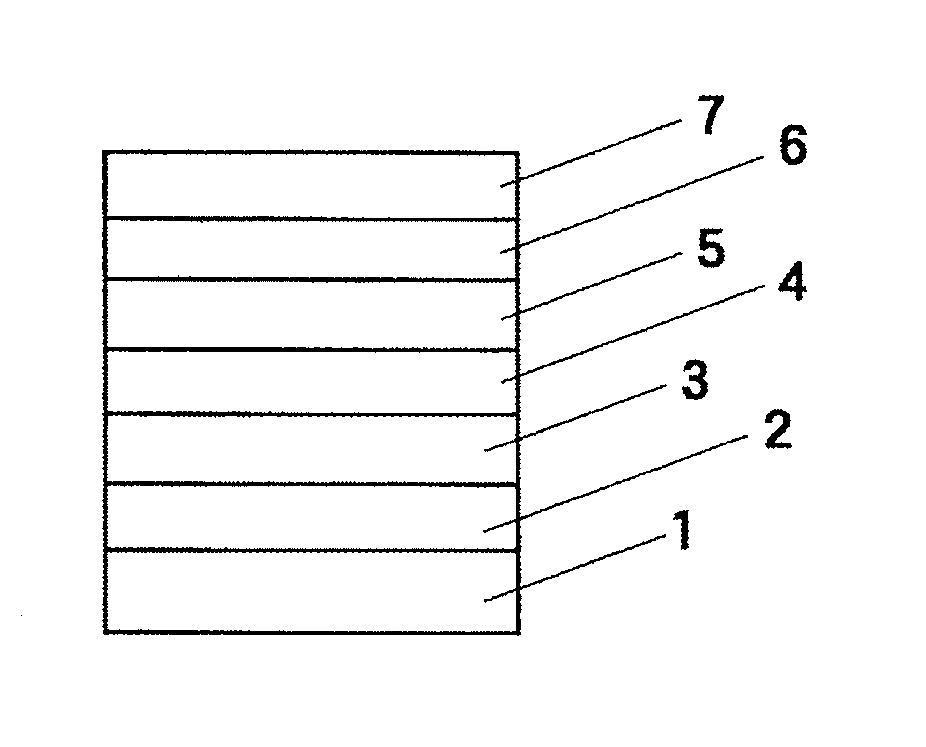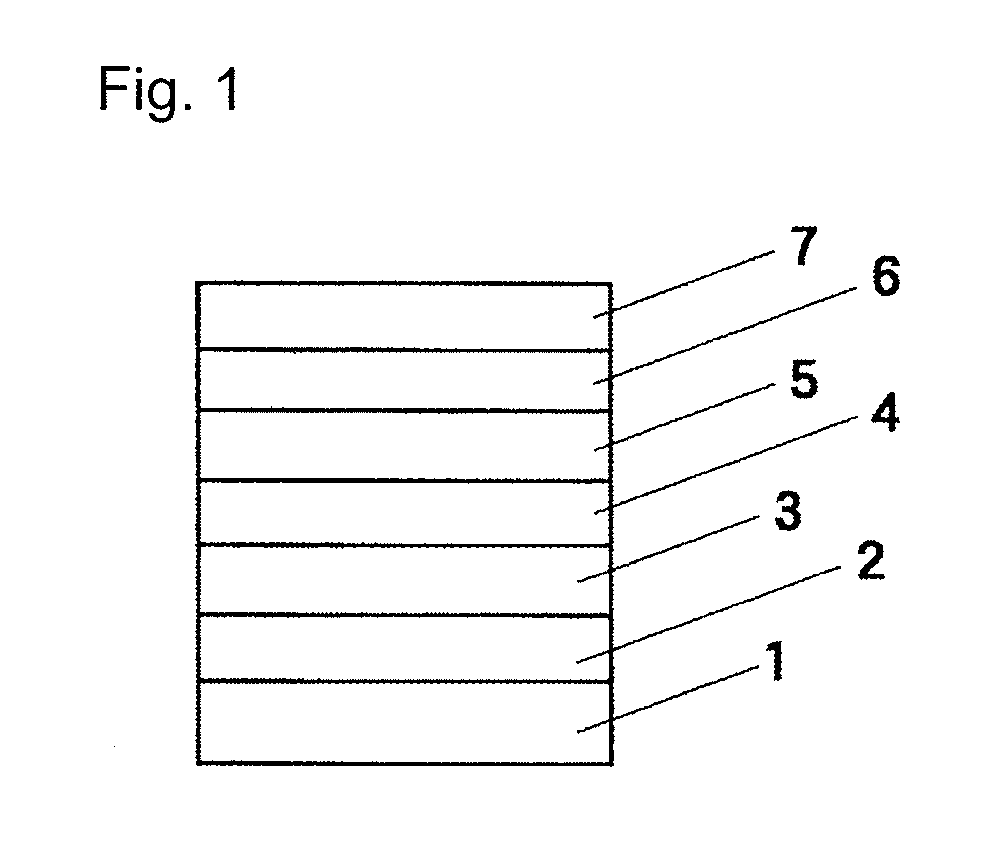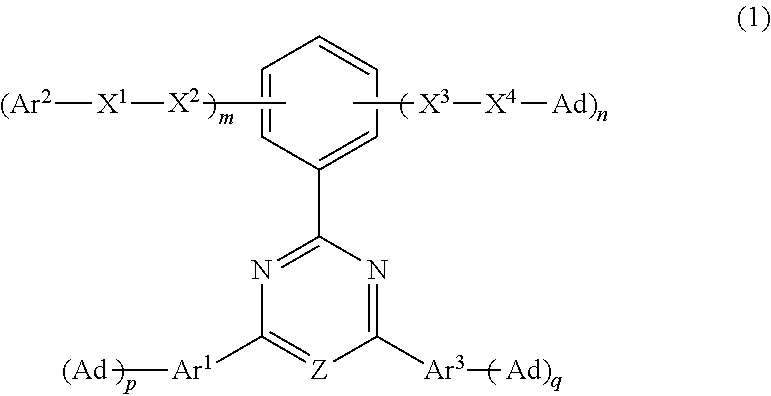Cyclic azine compound having adamantyl group, production method, and organic electroluminescent device containing it as constituent component
a technology of cyclic azine and adamantyl group, which is applied in the direction of organic chemistry, group 3/13 element organic compounds, and luminescent compositions. it can solve the problems of low emission luminance or luminous efficiency, low service life, and non-position of conventional organic electroluminescent devices, etc., to achieve excellent luminous efficiency, long service life, and high thermal resistance
- Summary
- Abstract
- Description
- Claims
- Application Information
AI Technical Summary
Benefits of technology
Problems solved by technology
Method used
Image
Examples
synthesis example 1
[0120]
[0121]Under an argon stream, 4-(1-adamantyl)phenol (3.77 g, 16.5 mmol) was suspended in dichloromethane (40 mL), and pyridine (2.66 mL, 33.0 mmol) was added. The obtained mixed solution was cooled to 0° C., a solution having anhydrous trifluoromethanesulfonic acid (5.59 g, 19.8 mmol) and dichloromethane (20 mL) mixed, was dropped slowly over a period of 15 minutes. The obtained reaction solution was stirred for 2 hours at 0° C. and then stirred at room temperature for 15 hours. After completion of the stirring, chloroform (30 mL) and a 2M HCl aqueous solution (30 mL) were added to the reaction solution and mixed by shaking, whereupon only the organic layer was taken out. The organic layer was dehydrated by addition of magnesium sulfate and filtered. By distilling off low-boiling point components from the organic layer, a yellowish white solid of 4-(1-adamantyl)phenyl triflate (amount: 5.50 g, yield:92.4%) was obtained as the desired compound.
[0122]1H-NMR (CDCl3): 1.76 (brq, J=...
synthesis example 2
[0123]
[0124]Under an argon stream, 2-(3-bromo-5-chlorophenyl)-4,6-diphenyl-1,3,5-triazine (25.0 g, 59.1 mmol), 3-pyridine boronic acid (12.0 g, 97.6 mmol), tetrakistriphenylphosphine palladium (2.05 g, 1.77 mmol) and potassium carbonate (24.5 g, 177 mmol) were suspended in a mixed solvent of tetrahydrofuran (500 mL) and water (177 mL), followed by heating to 70° C. and stirring for 18 hours. After the stirring, the reaction solvent was distilled off, and chloroform and water were added for dissolution again. Only the organic layer was taken out, and it was dehydrated by addition of magnesium sulfate and filtered. Low boiling point components in the obtained organic layer were distilled off, and the obtained gray white solid was purified by recrystallization with toluene, to obtain a gray white solid of 2-[5-chloro-3-(3-pyridyl) phenyl]-4,6-diphenyl-1,3,5-triazine (amount: 22.6 g, yield: 90.9%) as the desired product.
[0125]1H-NMR (CDCl3): 7.45 (dd, J=7.6 Hz, 4.8 Hz, 1H), 7.56-7.65 (m...
synthesis example 3
[0126]
[0127]Under an argon stream, 2-[5-chloro-3-(3-pyridyl) phenyl]-4,6-diphenyl-1,3,5-triazine (10.0 g, 23.8 mmol), bis(pinacolato)diboron (9.07 g, 35.7 mmol), potassium acetate (7.01 g, 71.4 mmol), palladium acetate (53.4 mg, 0.238 mmol) and 2-dicyclohexylphosphino-2′,4′,6′-triisopropyl biphenyl (227 mg, 0.476 mmol) were suspended in 1,4-dioxane (400 mL), followed by heating to 100° C. and stirring for 18 hours. Then, 500 mL of chloroform and 100 mL of water were added to the reaction solution and mixed by shaking, whereupon only the organic layer was taken out. The organic layer was dehydrated by addition of magnesium sulfate and filtered. After low-boiling point components in the obtained organic layer were distilled off, and the organic layer was dissolved in 150 mL of chloroform. To this chloroform solution, 1,000 mL of hexane was added, followed by stirring for 1 hour, whereupon the formed precipitate was collected by filtration, to obtain a white solid of 4,6-diphenyl-2-[3-...
PUM
| Property | Measurement | Unit |
|---|---|---|
| temperature | aaaaa | aaaaa |
| temperature | aaaaa | aaaaa |
| temperature | aaaaa | aaaaa |
Abstract
Description
Claims
Application Information
 Login to View More
Login to View More - R&D
- Intellectual Property
- Life Sciences
- Materials
- Tech Scout
- Unparalleled Data Quality
- Higher Quality Content
- 60% Fewer Hallucinations
Browse by: Latest US Patents, China's latest patents, Technical Efficacy Thesaurus, Application Domain, Technology Topic, Popular Technical Reports.
© 2025 PatSnap. All rights reserved.Legal|Privacy policy|Modern Slavery Act Transparency Statement|Sitemap|About US| Contact US: help@patsnap.com



